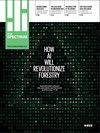机械巨塔
IF 2.6
4区 工程技术
Q2 ENGINEERING, ELECTRICAL & ELECTRONIC
引用次数: 0
摘要
2023 年底,亚特兰大佐治亚理工学院的研究人员推出了一个机器人表演雕塑,并将其命名为 Medusai。它是以美杜莎为原型设计的,美杜莎是神话中的高竿女妖,她把任何看她的人都变成了石头。这个机器人拥有蛇一样的手臂,可以同时演奏打击乐和弦乐,并与观察者互动 "跳舞"。"佐治亚理工学院音乐技术中心教授吉尔-温伯格(Gil Weinberg)解释说:"人工智能驱动的机器蛇跟随并威胁人类,这种阴森恐怖的概念与该雕塑激发人类突破创造力和表现力极限的潜力相平衡。本文章由计算机程序翻译,如有差异,请以英文原文为准。
Mechanical Megatalent
In late 2023, researchers at Georgia Tech in Atlanta unveiled a robotic performance sculpture they named Medusai. It is modeled after Medusa, the mythological Gorgon who turned anyone who looked at her to stone. The bot has snakelike arms that allow it to simultaneously play percussion and strings and interactively “dance” with observers. “The eerie and uncanny notion of AI-driven robotic snakes following and threatening humans is balanced by the sculpture's potential to inspire humans to push the boundaries of their creativity and expression,” explains Gil Weinberg, the professor at Georgia Tech's Center for Music Technology who heads the team that created Medusai.
求助全文
通过发布文献求助,成功后即可免费获取论文全文。
去求助
来源期刊

IEEE Spectrum
工程技术-工程:电子与电气
CiteScore
2.50
自引率
0.00%
发文量
254
审稿时长
4-8 weeks
期刊介绍:
IEEE Spectrum Magazine, the flagship publication of the IEEE, explores the development, applications and implications of new technologies. It anticipates trends in engineering, science, and technology, and provides a forum for understanding, discussion and leadership in these areas.
IEEE Spectrum is the world''s leading engineering and scientific magazine. Read by over 300,000 engineers worldwide, Spectrum provides international coverage of all technical issues and advances in computers, communications, and electronics. Written in clear, concise language for the non-specialist, Spectrum''s high editorial standards and worldwide resources ensure technical accuracy and state-of-the-art relevance.
 求助内容:
求助内容: 应助结果提醒方式:
应助结果提醒方式:


